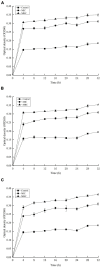Thinned-Young Apple Polyphenols Inhibit Halitosis-Related Bacteria Through Damage to the Cell Membrane
- PMID: 35281303
- PMCID: PMC8905352
- DOI: 10.3389/fmicb.2021.745100
Thinned-Young Apple Polyphenols Inhibit Halitosis-Related Bacteria Through Damage to the Cell Membrane
Abstract
The thinned young apple is a by-product and is generally discarded in the orchard during fruit thinning. The polyphenol content of thinned young apples is about 10 times more than that of ripe apples. In our study, the antibacterial effect of thinned young apple polyphenols (YAP) on the halitosis-related bacteria including Porphyromonas gingivalis, Prevotella intermedius, and Fusobacterium nucleatum was investigated. The minimum inhibitory concentrations of YAP against P. gingivalis, P. intermedia, and F. nucleatum were 8.0, 8.0, and 12.0 mg/ml, while the minimum bactericidal concentrations were 10.0, 10.0, and 14.0 mg/ml, respectively. The scanning electron microscopy and transmission electron microscopy analyses showed that after YAP treatment, the membrane surface of halitosis-related bacterial cells was coarse and the cell wall and membrane were separated and eventually ruptured. The integrity of the cell membrane was determined by flow cytometry, indicating that the cells with the integrity membrane significantly reduced as the YAP concentration treatment increased. The release of proteins and nucleic acids into the cell suspension significantly increased, and the membrane potential reduced after the YAP treatment. This research illustrated the antibacterial mechanism of YAP against halitosis-related bacteria and provided a scientific basis of utilizing the polyphenols from the discarded thinned young apples.
Keywords: Thinned-young apple polyphenols; antibacterial mechanism; cell membrane; halitosis; membrane potential.
Copyright © 2022 Liu, Shen, Wang, Zhou, Zhao, Yang and Guo.
Conflict of interest statement
The authors declare that the research was conducted in the absence of any commercial or financial relationships that could be construed as a potential conflict of interest.
Figures








Similar articles
-
Structural modification of thinned-young apple polyphenols-zinc complex and its antibacterial activity against halitosis-related bacteria.Int J Biol Macromol. 2025 May;306(Pt 1):141379. doi: 10.1016/j.ijbiomac.2025.141379. Epub 2025 Feb 21. Int J Biol Macromol. 2025. PMID: 39988150
-
Improved antibacterial effects of alkali-transformed saponin from quinoa husks against halitosis-related bacteria.BMC Complement Altern Med. 2019 Feb 12;19(1):46. doi: 10.1186/s12906-019-2455-2. BMC Complement Altern Med. 2019. PMID: 30755185 Free PMC article.
-
Evaluation of the antibacterial activity of Elsholtzia ciliate essential oil against halitosis-related Fusobacterium nucleatum and Porphyromonas gingivalis.Front Microbiol. 2023 Aug 7;14:1219004. doi: 10.3389/fmicb.2023.1219004. eCollection 2023. Front Microbiol. 2023. PMID: 37608950 Free PMC article.
-
Characterization of Eurotium cristatum Fermented Thinned Young Apple and Mechanisms Underlying Its Alleviating Impacts on Experimental Colitis.J Agric Food Chem. 2024 Jul 24;72(29):16221-16236. doi: 10.1021/acs.jafc.4c02005. Epub 2024 Jul 12. J Agric Food Chem. 2024. PMID: 38996349
-
Halitosis vaccines targeting FomA, a biofilm-bridging protein of fusobacteria nucleatum.Curr Mol Med. 2013 Sep;13(8):1358-67. doi: 10.2174/15665240113139990063. Curr Mol Med. 2013. PMID: 23865430 Review.
Cited by
-
Young apple polyphenol extract prevents diabetic cognitive dysfunction by promoting TET2-mediated active DNA demethylation in the brain of diabetic mice.Front Nutr. 2025 May 2;12:1580775. doi: 10.3389/fnut.2025.1580775. eCollection 2025. Front Nutr. 2025. PMID: 40386213 Free PMC article.
-
Anti-Bacterial and Anti-Biofilm Activities of Essential Oil from Citrus reticulata Blanco cv. Tankan Peel Against Listeria monocytogenes.Foods. 2024 Nov 28;13(23):3841. doi: 10.3390/foods13233841. Foods. 2024. PMID: 39682912 Free PMC article.
-
Polyphenols in Oral Health: Homeostasis Maintenance, Disease Prevention, and Therapeutic Applications.Nutrients. 2023 Oct 16;15(20):4384. doi: 10.3390/nu15204384. Nutrients. 2023. PMID: 37892459 Free PMC article. Review.
-
A comprehensive review of unlocking the potential of lignin-derived biomaterials: from lignin structure to biomedical application.J Nanobiotechnology. 2025 Jul 24;23(1):538. doi: 10.1186/s12951-025-03604-7. J Nanobiotechnology. 2025. PMID: 40707932 Free PMC article. Review.
-
Polyphenols from Thinned Young Apples: HPLC-HRMS Profile and Evaluation of Their Anti-Oxidant and Anti-Inflammatory Activities by Proteomic Studies.Antioxidants (Basel). 2022 Aug 15;11(8):1577. doi: 10.3390/antiox11081577. Antioxidants (Basel). 2022. PMID: 36009298 Free PMC article.
References
-
- Bajpai V. K., Sharma A., Baek K. H. (2013). Antibacterial mode of action of Cudrania tricuspidata fruit essential oil, affecting membrane permeability and surface characteristics of food-borne pathogens. Food Control 32 582–590. 10.1016/j.foodcont.2013.01.032 - DOI
-
- Ben L. A., Dudonné S., Desjardins Y., Grenier D. (2015). Wild Blueberry (Vaccinium angustifolium Ait.) Polyphenols Target Fusobacterium nucleatum and the Host Inflammatory Response: potential Innovative Molecules for Treating Periodontal Diseases. J. Agric. Food. Chem. 63 6999–7008. 10.1021/acs.jafc.5b01525 - DOI - PubMed
LinkOut - more resources
Full Text Sources

